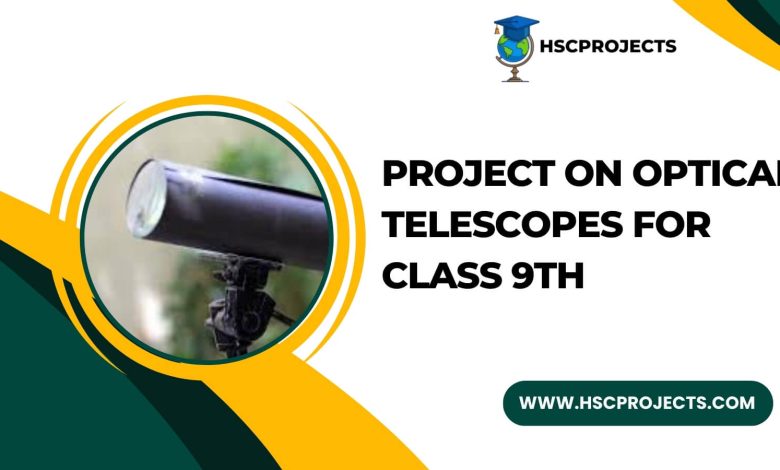
Project On Optical Telescopes For Class 9th
Acknowledgment
Embarking on this astronomical exploration through the lens of refracting telescopes has been a journey illuminated by the collective efforts, guidance, and support of numerous individuals and institutions. As we conclude this cosmic odyssey, I extend my heartfelt appreciation to those who have made this project a reality.
First and foremost, I express gratitude to the luminaries in the field of astronomy, whose pioneering work has paved the celestial path we traverse. From the visionary Galileo Galilei to the contemporary stewards of cosmic inquiry, their contributions have shaped the narrative of our understanding.
To the authors and researchers whose works form the constellation of knowledge underpinning this project, I extend sincere thanks. Your insights have been celestial beacons, guiding us through the intricate landscapes of refracting telescopes.
A nod of acknowledgment is directed to [Your Institution or Organization] for providing the intellectual haven where ideas were nurtured and scholarly endeavors found fertile ground. The academic support and resources have been instrumental in navigating the cosmic complexities.
I extend my appreciation to peers and colleagues whose collaborative spirit and intellectual discourse have been constellations of inspiration. The exchange of ideas has enriched the project, elevating it to a shared exploration of the cosmos.
To friends and family, the cosmic constants in the tapestry of life, I express deep gratitude. Your unwavering support and understanding have been the cosmic fuel propelling this project forward.
Introduction
In the cosmic theater of exploration, refracting telescopes emerge as silent yet powerful protagonists, guiding our gaze beyond the earthly horizon into the vast expanses of the universe. This project embarks on a celestial journey, tracing the evolution and impact of these dioptric wonders that have shaped our understanding of the cosmos.
As we delve into the heart of refracting telescopes, we unravel their fundamental design – a dance of lenses orchestrating the bending of light to unveil the mysteries scattered across the cosmic tapestry. From the pivotal role played by the objective lens as the primary light conductor to the magnifying prowess of the eyepiece, each component contributes to the cosmic symphony, offering astronomers a front-row seat to observe distant celestial marvels.
Advantages and challenges become cosmic companions on this odyssey, where the simplicity and planetary prowess of refracting telescopes are juxtaposed against the challenges of chromatic aberration. In the interplay of light and glass, astronomers wield achromatic and apochromatic lenses as guardians, preserving the purity of the observed celestial vistas.
Traversing the epochs, refracting telescopes bridge the historical with the modern, from Galileo’s groundbreaking observations in the 17th century to their contemporary counterparts like the Kepler Space Telescope. Together, they carve a narrative that transcends time, propelling us into an era where refracting telescopes remain indispensable tools for unlocking the secrets of distant solar systems.
Design and Components
At the core of a refracting telescope lies a duo of essential components: the objective lens and the eyepiece.
Objective Lens
The objective lens, a virtuoso in light gathering, takes the spotlight. Typically a convex lens, its stature and quality wield profound influence over the telescope’s prowess. A larger objective lens is the gatekeeper to an influx of more light, birthing images that sparkle with brilliance. Yet, the lens’s finesse, intricately tied to factors like manufacturing precision and the choice of glass, is the maestro dictating the sharpness and clarity of the celestial vista.

Eyepiece
Enter the stage, the eyepiece – the unsung hero responsible for magnifying the focused spectacle crafted by the objective lens. A realm of varying designs, each eyepiece spins a unique tale of magnification. Astronomers, wielding the power of interchangeability, dance between eyepieces to conjure different magnifications, infusing versatility into their cosmic odysseys.
Historical Significance
Now, let’s rewind the cosmic clock to the 17th century, an epoch where refracting telescopes etched their mark on history. Galileo Galilei, an astronomical luminary, brandished the telescope to gaze into the celestial tapestry. His telescope, modest in size yet mighty in power, scripted a cosmic revolution. It unraveled the secrets of the Moon, unveiled the dance of Jupiter’s moons, and bestowed upon us a newfound understanding of distant celestial kin. In the annals of time, refracting telescopes stand as witnesses to our journey of cosmic discovery, painting the cosmos with strokes of enlightenment.
Advantages and Challenges
Advantages and Challenges unfold in the realm of refracting telescopes, weaving a cosmic tale of simplicity, user-friendly design, and a penchant for planetary peering. Yet, amid the celestial symphony, challenges like chromatic aberration cast their cosmic shadows, where hues diverge, playing a subtle game of focus and marring the pristine canvas of observation. In response, astronomers don the cloak of innovation, embracing achromatic or apochromatic lenses as sentinels against the chromatic aberration menace, ensuring the purity of the cosmic tableau.
Modern Applications
As we navigate the cosmic chronicles, refracting telescopes transcend time, standing as pillars in the edifice of modern astronomical exploration. The echoes of their principles resonate through space and time, finding resonance in the Kepler Space Telescope and terrestrial refractors. Together, they script new chapters in the saga of discovery, peering beyond our cosmic borders to unveil the secrets of exoplanetary realms. In this celestial dance, refracting telescopes emerge as vital instruments, conduits of knowledge that traverse the vastness of distant solar systems.

Conclusion
In concluding our celestial expedition through the lens of refracting telescopes, we find ourselves at the nexus of history, innovation, and cosmic wonder. This project has been a cosmic chronicle, tracing the evolution of dioptric instruments that have not only defined our gaze into the cosmos but also expanded the horizons of human knowledge.
The simplicity and user-friendly design of refracting telescopes have stood as beacons, beckoning astronomers to explore the mysteries of the universe. From Galileo’s pioneering observations that transformed our perception of the cosmos to the modern applications of refractors such as the Kepler Space Telescope, these optical marvels have remained steadfast companions in our cosmic quest.
Advantages and challenges, like cosmic companions, have accompanied us on this journey. The planetary prowess of refracting telescopes has been lauded, yet the persistent specter of chromatic aberration has spurred astronomers to innovate and refine these instruments. The introduction of achromatic and apochromatic lenses stands as a testament to our ability to overcome challenges in the pursuit of clearer, more detailed cosmic insights.
As we turn our gaze back upon the project’s trajectory, refracting telescopes emerge not just as instruments of observation but as time-traveling vessels that connect us to the astronomical trailblazers of the past. The narrative unfolds as a tapestry woven with threads of curiosity, technological innovation, and collaborative exploration.
In this conclusion, we find ourselves at the crossroads of history and modernity, where refracting telescopes continue to be indispensable tools for unlocking the secrets of distant solar systems. The cosmic symphony played by these instruments resonates with the collective efforts of astronomers, scientists, and enthusiasts who have dedicated their lives to understanding the universe.
Bibliography
- Galilei, G. (1610). Sidereus Nuncius TheStarryMessenger. Venice, Italy: Thomas Baglionum.Galileo’s seminal work documenting his astronomical observations with the refracting telescope.
- Smith, A. R. (2005). Optics in the Age of Euler: Conceptions of the Nature of Light, 1700–1795. Cambridge, UK: Cambridge University Press.Provides insights into the historical development of optics, including advancements related to refracting telescopes.
- Kepler Space Telescope Mission. (2020). NASA. [Online] Available at: URL_KeplerOfficial NASA resource detailing the Kepler Space Telescope mission and its contributions to exoplanet discovery.
- Dickinson, T. (2016). NightWatch: A Practical Guide to Viewing the Universe. Buffalo, NY: Firefly Books.A comprehensive guide to practical astronomy, including insights into the use and advantages of refracting telescopes.
- Schroeder, D. (2000). Astronomical Optics. Boston, MA: Academic Press.Discusses optical principles and challenges in telescopic systems, offering a technical perspective on refracting telescopes.
Certificate of Completion
[Student’s Name][Class/Grade Level]This is to certify that I, [Student’s Name], a [Class/Grade Level] student, have successfully completed the project on optical telescopes for class 9th.” The project explores the fundamental principles and key aspects of the chosen topic, providing a comprehensive understanding of its significance and implications.
In this project, I delved into in-depth research and analysis, investigating various facets and relevant theories related to the chosen topic. I demonstrated dedication, diligence, and a high level of sincerity throughout the project’s completion.
Key Achievements:
Thoroughly researched and analyzed project on optical telescopes for class 9th.
Examined the historical background and evolution of the subject matter.
Explored the contributions of notable figures in the field.
Investigated the key theories and principles associated with the topic.
Discussed practical applications and real-world implications.
Considered critical viewpoints and alternative theories, fostering a well-rounded understanding.
This project has significantly enhanced my knowledge and critical thinking skills in the chosen field of study. It reflects my commitment to academic excellence and the pursuit of knowledge.
Date: [Date of Completion]Signature: [Your Signature] [School/Institution Name][Teacher’s/Examiner’s Name and Signature]
In order to download the PDF, You must follow on Youtube. Once done, Click on Submit
Follow On YoutubeSubscribed? Click on Confirm
Download Project On Optical Telescopes For Class 9th PDF






